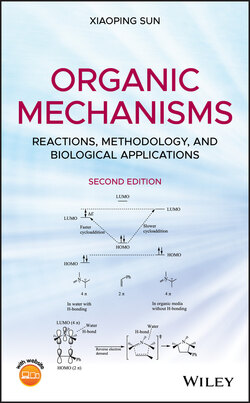Читать книгу Organic Mechanisms - Xiaoping Sun - Страница 25
1.6 THE TRANSITION STATE 1.6.1 The Transition State and Activation Energy
ОглавлениеThe transition state is the structural bridge that links reactants and products for any concerted chemical reactions. In order for the reactant molecules to collide effectively giving the products, they must overcome an energy barrier, which is called activation energy (Ea) (Fig. 1.4). This is true for both exergonic (ΔG < 0, Fig. 1.4a) and endergonic (ΔG > 0, Fig. 1.4b) reactions. The activation energy (Ea) is a free energy term, which includes contributions from both enthalpy and entropy. The state in which the reaction system reaches a maximum energy level in the energy profile (Fig. 1.4a or b) is called transition state. It is also referred to as activated complex in which reorganization of the atoms in the reactant molecules are taking place such that some old bonds are being partially broken, coincident with the partial formation of some new bonds. The transition state (activated complex) is highly energetic and therefore, it is in general very unstable and short‐lived [with the half‐life being in the order of picosecond (10−12 s) for many reactions]. Once formed, it rapidly collapses (dissociates) spontaneously. As a result, the old bonds in the reactants are fully broken, and simultaneously, the new bonds are completely formed, giving the final stable products in the end of the reaction.
FIGURE 1.4 Early transition state (a) and late transition state (b).
In a concerted reaction (Fig. 1.4), the activation energy (Ea) is equal to the free energy of the transition state (Ea = ΔG‡ = ΔΗ‡ – TΔS‡). ΔG‡, ΔΗ‡, and ΔS‡ are the difference in free energy, enthalpy, and entropy values, respectively, between the transition state and the reactants (ΔG‡ = GTS − Greactants, etc.), and they are referred to as free energy, enthalpy, and entropy of the transition state. In the case that the entropy (ΔS‡) effect is small and can be neglected, the activation energy is then approximately equal to the activation enthalpy (Ea = ΔΗ‡). In the individual chapters, we will see that this approximation is very often valid and works well for many reactions. The energy level (in the free energy term) that the transition state possesses is the quantitative measure for the stability of the transition state. A fast reaction requires a relatively stable transition state (with a relatively low energy level). A reaction is getting slower as the stability of the transition state decreases (with an increase in its energy level). The quantitative relationship between the rate constant (k) of a reaction (concerted) and the activation energy (Ea) is described by the well‐known Arrehnius equation (Eq. 1.54):
(1.54)
